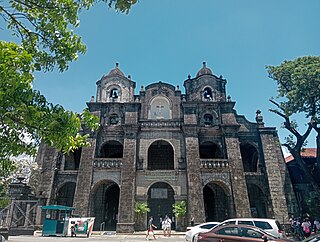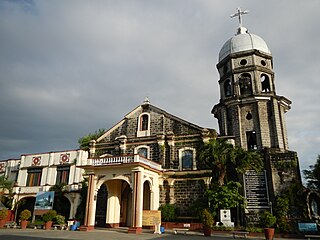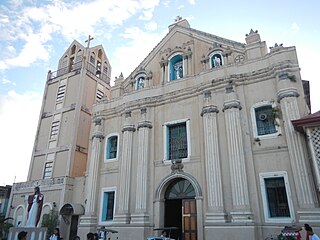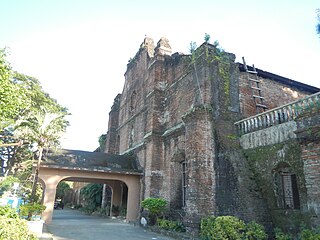
Aguilar, officially the Municipality of Aguilar, is a 3rd class municipality in the province of Pangasinan, Philippines. According to the 2020 census, it has a population of 45,100 people.

Bugallon, officially the Municipality of Bugallon, is a 2nd class municipality in the province of Pangasinan, Philippines. According to the 2020 census, it has a population of 74,962 people.
The Pangasinan language belongs to the Malayo-Polynesian languages branch of the Austronesian languages family. Pangasinan is spoken primarily in the province of Pangasinan in the Philippines, located on the west central area of the island of Luzon along Lingayen Gulf.

The Archdiocese of San Fernando is the archdiocese of the Latin Church of the Catholic Church in Pampanga, Philippines which has territorial jurisdiction over the whole province of Pampanga and Angeles City. The archdiocese is also the metropolitan see of the ecclesiastical province of the same name, which also include three dioceses of its surrounding provinces of Bataan, Zambales, and Tarlac. The cathedral church and seat of the archdiocese is the Metropolitan Cathedral of San Fernando (Pampanga). The Virgin Mary, under the title Virgen de los Remedios, is the principal patroness.

The Saints Peter and Paul Parish Church, commonly known as Calasiao Church, is a baroque church located in Poblacion West, Calasiao, Pangasinan, Philippines. It belongs to the Vicariate of Sts. Peter and Paul under the Ecclesiastical Province of the Roman Catholic Archdiocese of Lingayen-Dagupan. The 57,840 Catholics is under the pastoral care of Rev. Fidelis B. Layog, assisted by Rev. Isidro Palinar, Jr. and Rev. Raymund Manaois.

The Santuario del Santo Cristo, also known as the Church of San Juan del Monte is a church and convento in San Juan, Metro Manila, Philippines. The shrine was built in 1602–1604 by the Dominicans on land that was donated to the order. Both the church and convento were burnt and destroyed during the Chinese insurrection of 1639, and later rebuilt in 1641. It was again destroyed in July 1763 as Britain briefly occupied Manila during the Seven Years' War. The current church and convento were built in 1774, and used as a shelter by Katipuneros during the 1898 Philippine Revolution against the Spanish Empire. It has since been renovated many times until the 1990s.

The Santo Tomas de Villanueva Church is a Roman Catholic church and the fourth oldest parish in the Diocese of Pasig in the Philippines. Santolan's 200-year-old patron saint is Thomas of Villanova, an Augustinian bishop and man of charity but unknown in the Manila area.

The Archdiocesan Shrine and Parish of Saint Joseph the Patriarch, also known as Saint Joseph the Patriarch Church, is a Roman Catholic church located in the town center of San Jose, Batangas, in the Philippines. The church is known for being one of the parishes that Fr. Manuel Blanco OSA, who authored the Flora de Filipinas, administered.

The Saint Agustine Parish Church, also known as the Lubao Church, is a 17th-century Neo-classic, Spanish stone and brick church located at Brgy. San Nicolas 1st, Lubao, Pampanga, Philippines. In 1952, a historical marker bearing a brief history of the structure was installed on the facade of the church by the Historical Committee of the Philippines, precursor of the National Historical Commission of the Philippines. In 2013, the church has been declared by the National Museum of the Philippines as an Important Cultural Property.

The San Andres Apostol Parish Church, commonly referred to as Candaba Church, is a 17th-century, Baroque church located at Barangay Pescadores, Candaba, Pampanga, Philippines. The parish church, dedicated to Saint Andrew the Apostle, is under the Roman Catholic Archdiocese of San Fernando.

The Saint Vincent Ferrer Parish Church, also known as Bayambang Church, is a Roman Catholic church located in the municipality of Bayambang in Pangasinan, Philippines. It is under the jurisdiction of the Archdiocese of Lingayen-Dagupan. The parish church celebrated its quadricentennial year in April 2019, coinciding with the completion of the 50.23-metre (164.8 ft) St. Vincent Ferrer Statue.

The Saint James the Great Parish Church, also known as Bolinao Church, is a Spanish colonial Roman Catholic church located at Brgy. Germinal in Bolinao, Pangasinan, Philippines. The church was made out of black coral stones. The church underwent series of natural and man-made calamities, such as the 1788 earthquake, 1819 fire incident, and Typhoon Emong in 2009.

The Our Lady of Lourdes Parish Church, also known as the Salasa Parish Church, is a Spanish colonial Roman Catholic church located in the municipality of Bugallon in Pangasinan, Philippines. The church is under the jurisdiction of the Roman Catholic Diocese of Alaminos. Its feast day is celebrated every February 11.

The Immaculate Conception Parish Church, also referred to as Shrine of the Immaculate Conception, Santuario de la Inmaculada Concepcion or Concepcion Church, is a late 19th-century, Baroque Roman Catholic church located at Brgy. San Nicolas Poblacion, Concepcion, Tarlac, Philippines. The parish church, under the aegis of Our Lady of the Immaculate Conception, is under the jurisdiction of the Roman Catholic Diocese of Tarlac.

Santa Rosa de Lima Parish Church is a Catholic church in Santa Rosa, Laguna, Philippines. Established in 1792, it is the first and oldest named parish dedicated to Saint Rose of Lima in the Philippines.

The Saint Catherine of Alexandria Cathedral Parish, better known as Dumaguete Cathedral, is a Roman Catholic cathedral in Dumaguete, Negros Oriental, Philippines. The cathedral is the seat of the Roman Catholic Diocese of Dumaguete and is considered as the island's oldest stone church having been completed in 1776.

Tagbilaran Cathedral, officially named as the Diocesan Shrine and Cathedral-Parish of Saint Joseph the Worker, is a Roman Catholic cathedral in Tagbilaran, capital city of Bohol province, in Central Visayas, Philippines. It is the seat of the Diocese of Tagbilaran which comprises Bohol's western half. The cathedral is located in Tagbilaran poblacion and was installed with a historical marker by the NHCP in 1953.

The Saint Joseph the Patriarch Cathedral Parish, also known as Alaminos Cathedral, is a Roman Catholic cathedral located at Barangay Poblacion in the city of Alaminos, Pangasinan, Philippines. Dedicated to Saint Joseph the Patriarch, it has been the episcopal seat of the Diocese of Alaminos since 1985.

Our Lady of the Immaculate Conception Cathedral, commonly known as the Urdaneta Cathedral, is a cathedral of the Roman Catholic Church located in the city of Urdaneta, Pangasinan in the Ilocos Region of the Philippines. Situated at Barangay Poblacion of Urdaneta, it is the seat of the Roman Catholic Diocese of Urdaneta and is dedicated to Mary under the title of Our Lady of the Immaculate Conception.






















